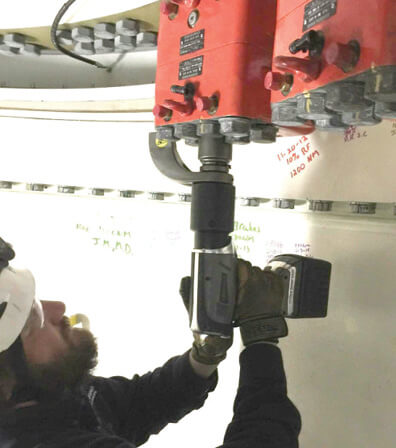It was not long ago that a wrench was just a wrench. Along came more complex tasks that brought up questions regarding accuracy and safety. Tools changed with hydraulic capability, then electric versions, and more recently the idea of a bolting system entered discussions. A bolting system?
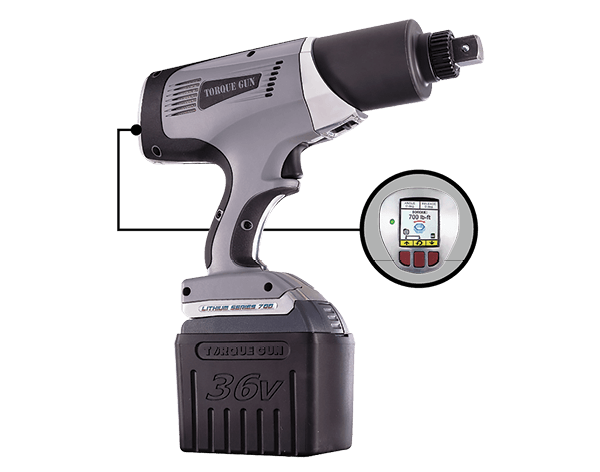
The HYTORC Lithium Gun works on 36V and is capable of tightening about 100 bolts on one charge. The tool comes with two batteries.
“It’s the unique combination of equipment that’s the best for each job,” says HYTORC COO Jason Junkers. “The tool itself, whether it is hydraulic, pneumatic, or electric, is the center of the system. From there we determine the best reaction fixtures, fasteners, lubrication and accessories to make the job as safe and accurate as possible. Hydraulic tools require an appropriately sized pump for the job, and consideration of special limitations such as overhead clearance, or general working space, like the confines of a wind turbine nacelle. So a bolting system is really a combination of things that make it best suited for the specific application it’s being used on.”
Things keep changing
One safety goal, for example, is to get away from external moving parts, such as reaction arms, the fixture most commonly used to stop the tool from turning during high powered tightening and loosening operations. “Those are the most dangerous part of bolting. It’s where most injuries come from,” says Junkers. A few recent wrenches do not require reaction arms.
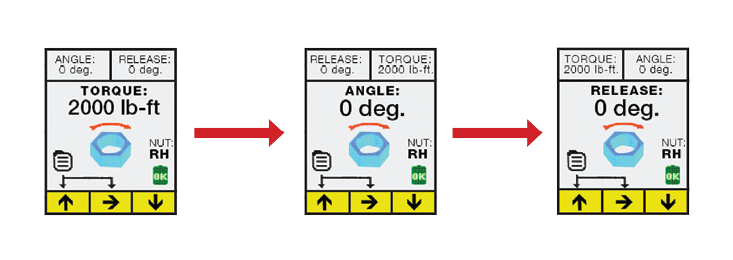
To set torque: On the first screen, use the up and down arrows to select the required torque. When reached, a green light turns on and the gun stalls. The battery icon and the “OK” signal a charged battery. Middle screen: Setting an angle to more than zero tells the gun to add this amount of rotation after reaching the required torque. The last screen provides a release angle before removing the tool.
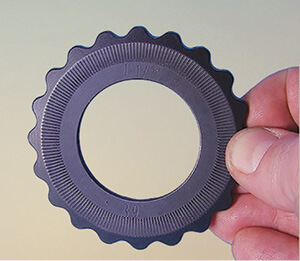
Getting OEMs to adopt new ideas can be challenging, but wind-farm owners looking to trim costs are more likely to consider new O&M thinking. One new bolting idea is the washer that increases safety by eliminating external reaction points and prevents bolts from coming loose in the presence of constant vibration.
And to encourage efficiency, Junkers says his company engineers have developed a kit for most every job in the turbine. The purpose of the kits is to make a job as intuitive as possible. “It reduces the amount of training that’s necessary, so anyone in the nacelle can say, ‘This tool is made for the brake bolts, this one is for blade bolts, and I just have to put it on the wrench and lock it into place,” he adds
The electrification of wind-turbine bolting
The difference between hydraulic and electric systems is significant enough to warrant a technical upgrade. The transition is more complex than putting down one tool and picking up another. For instance, the right tool depends on a lot of things, the first of which should be whether or not the electric wrench can do the job.
The largest sized HYTORC Lithium Gun is capable of about 3,000 ft-lb. “Even when the job calls for 3,000 ft-lb, we recommend at least 30% more capacity — about 3,900 ft-lb, for breaking-out or loosening nuts — which would eliminate use of the electric tools. Still, electric versions are becoming more widely used. Most bolting in the wind turbine is within the range of electric tools,” says Junkers.
Many supply companies offer free or inexpensive safety and operational training when clients purchase new products. “A problem in the wind industry is that these tools are often shared among sites or shipped with kits to the sites, so users may expect one and get the other. However, even when techs are at a wind farm in the middle of nowhere, a call to the local distributor will get a service van to the site for hands-on safety and operational training.”
That’s important because the tools look familiar. “Many people use battery or plug-in power drills, so a wind tech might figure that using a new wrench is straightforward. But when dealing with 3,000 ft-lb, and especially when using a reaction arm, there are safety risks. Users must be trained on correct use and in the availability of fixtures that can make the job safer.”
Hydraulic tools have their place and advantages, such as higher torques, and they can power multiple tools simultaneously. But the pump can weight 80 lbs or more, and torque is controlled by setting a pressure limit on the pump.
Most benefits of the electric wrenches are related to convenience and portability. Unlike hydraulic tools, the electrics don’t need the heavy pump and that’s a big benefit especially in wind power when technicians
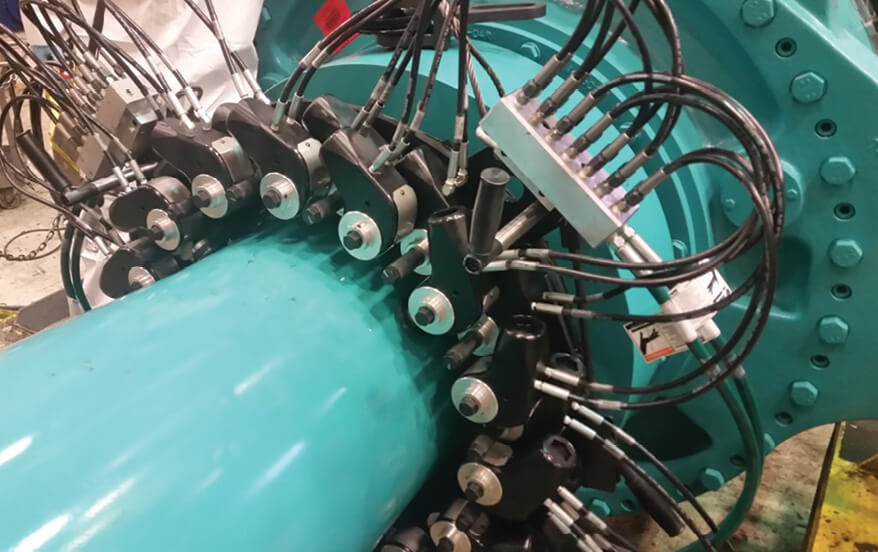
One plus for hydraulic tools is that they can, thanks to the custom rig designed by HYTORC engineers, tighten all the bolts on a mainshaft at one time.
must climb towers to the nacelles. “On the electric tool, a green light tells when the selected torque has been reached. Users can also choose the turn-of-nut method, which is simpler with electrics. Both settings are performed in one shot. Pull the trigger and the wrench does the torqueing, followed by the turn of angle,” says Junkers.
But how long does the battery last? “The work time on a battery charge is difficult to answer because of many variables, such as tightening or loosening bolts, dry or lubed threads, and high torque or low. But in general, many users can torque around 100 nuts on a single charge. And the tool comes with two batteries.”
Filed Under: Featured

